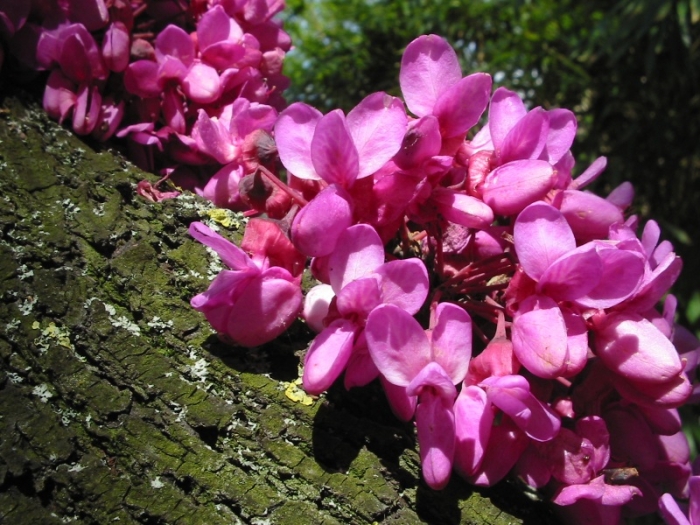Judas Tree
(Cercis siliquastrum)
Judas Tree (Cercis siliquastrum)
/
/

Bouba Wikipedia
CC BY-SA 3.0
Image By:
Bouba Wikipedia
Recorded By:
Copyright:
CC BY-SA 3.0
Copyright Notice:
Photo by: Bouba Wikipedia | License Type: CC BY-SA 3.0 | License URL: http://creativecommons.org/licenses/by-sa/3.0/ | Uploader: Bilou~commonswiki | Publisher: Wikimedia Commons | Title: Cercis_siliquastrum.jpg | Notes: {{location|40|31|14.81|N|8|43|37.3|E|region:IT}} {{Information |Description= ''[[Cerinthe major]]'' L. 1753 {{en|Honeywort near Thiesi, Sardinia, Italy.}} |Source= {{own}} |Date= 2010-04-07 |Author= [[User:Lycaon|Hans Hillewaert]] |Permission= {{self|cc-





























































Estimated Native Range
Summary
Cercis siliquastrum, commonly known as Judas Tree, is a deciduous tree native to open woodlands and forest edges in Southern Europe, the Eastern Mediterranean, and Iran. It reaches a typical height and width of 15-25 feet (4.5-7.6 meters), forming a rounded canopy with a balanced, bushy appearance. The Judas Tree is celebrated for its abundant spring blossoms, which are deep pink to reddish-purple and appear before the leaves, covering the branches, stems, and sometimes even the trunk, creating a striking floral display. The flowering season is in April and May, and the flowers are showy, with a characteristic pea-like shape due to its membership in the Fabaceae family.
The Judas Tree is valued for its stunning floral display and heart-shaped leaves that emerge shortly after the flowers, providing a fresh green contrast. It is often used in urban planting, border planting, and as a specimen tree in gardens for its ornamental qualities. The tree is relatively easy to maintain, tolerating a range of soil types, provided they are well-drained. It prefers full sun to partial shade and requires moderate watering. While it is generally disease-resistant, it can be susceptible to canker and verticillium wilt. The tree’s seed pods are also noteworthy, hanging in clusters and adding visual interest even after the leaves fall. The edible flowers, which have a sweet-acid taste, can be used in salads or as a garnish. Propagation can be achieved through seeds, cuttings, or budding, although seedlings may take several years to flower.CC BY-SA 4.0
The Judas Tree is valued for its stunning floral display and heart-shaped leaves that emerge shortly after the flowers, providing a fresh green contrast. It is often used in urban planting, border planting, and as a specimen tree in gardens for its ornamental qualities. The tree is relatively easy to maintain, tolerating a range of soil types, provided they are well-drained. It prefers full sun to partial shade and requires moderate watering. While it is generally disease-resistant, it can be susceptible to canker and verticillium wilt. The tree’s seed pods are also noteworthy, hanging in clusters and adding visual interest even after the leaves fall. The edible flowers, which have a sweet-acid taste, can be used in salads or as a garnish. Propagation can be achieved through seeds, cuttings, or budding, although seedlings may take several years to flower.CC BY-SA 4.0
Plant Description
- Plant Type: Tree
- Height: 15-25 feet
- Width: 15-25 feet
- Growth Rate: Moderate
- Flower Color: Pink, Purple
- Flowering Season: Spring
- Leaf Retention: Deciduous
Growth Requirements
- Sun: Full Sun, Part Shade
- Water: Medium
- Drainage: Slow, Medium, Fast
Common Uses
Bee Garden, Bird Garden, Butterfly Garden, Deer Resistant, Drought Tolerant, Edible*Disclaimer: Easyscape's listed plant edibility is for informational use. Always verify the safety and proper identification of any plant before consumption., Low Maintenance, Showy Flowers, Street Planting
Natural Habitat
Native to open woodlands and forest edges in Southern Europe, the Eastern Mediterranean, and Iran
Other Names
Common Names: Lovetree, Judastree, Judas Tree, Arbre De Judee, Bagryannik Rozhkovyi, Iudino Derevo, Tzertzis Evropeiski, Tzertzis Rozhkovyi, Judasträd, Arbol De Judea
Scientific Names: , Cercis siliquastrum, Cercis florida, Siliquastrum orbicularis,
GBIF Accepted Name: Cercis siliquastrum L.